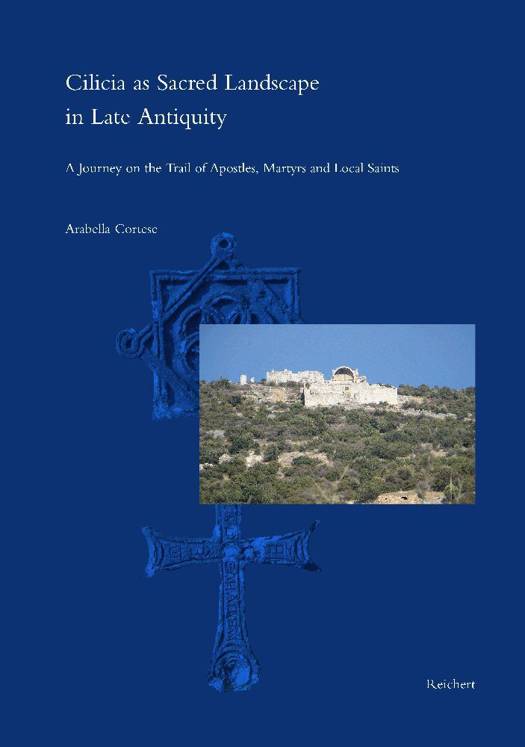
- Retrait gratuit dans votre magasin Club
- 7.000.000 titres dans notre catalogue
- Payer en toute sécurité
- Toujours un magasin près de chez vous
- Retrait gratuit dans votre magasin Club
- 7.000.0000 titres dans notre catalogue
- Payer en toute sécurité
- Toujours un magasin près de chez vous
Description
English summary: Cilicia as Sacred Landscape in Late Antiquity is a journey of discovery of the rich religious landscape of Cilicia in Asia Minor in Late Antiquity, with its contrasting and fascinating natural landscapes. Famous and prosperous cities of Cilicia Pedias such as Tarsos and Anazarbos welcomed pilgrims from distant western lands on their way to Jerusalem, attracted by famous stories about their saints and especially the Apostle Paul. The rugged mountains that characterized the western part of Cilicia (so-called Isauria) concealed places of worship associated mainly with the memory of Saint Thekla, whose place of pilgrimage was located a few kilometres south of the city of Seleukeia on the Kalykadnos, and of local martyrs, like Saint Konon, who were sometimes venerated internationally. The present book examines all the archaeological and architectural evidence (building remains, inscriptions, decorations, mosaics, coins) that testify to the veneration of saints in Cilicia and Isauria, and integrates them with hagiographic evidence that tells us, above all, about the places where the saints stayed, performed their miracles, and died. Particular attention is paid both to the physical characteristics of the region, which strongly influenced the construction of religious structures in certain places and shaped their form (often integrated into the landscape), and to the historicity of the sites. Indeed, numerous churches were built on earlier pagan structures (temples, thermae, agora, rock or water sanctuaries). The central questions of the book are concerned with how martyria and pilgrimage sites affected the spatial planning (roads, accessibility, buildings) of the region, how the worship of a saint was organized in its pilgrimage sites, how existing structures contributed to the sacrality of a site and offered a continuity with the past, and, finally, how the particular relationship between sacrality and nature was enacted architecturally. This volume is an archaeological work that focuses on the late antique process of creating sacred space in a marginal but extensively travelled region of Asia Minor. Combining the architectural and archaeological analysis of Christian church buildings and martyria with literary sources attesting the cult of a saint, it aims to reconstruct the sacred landscape of an underestimated region through the lens of a pilgrim and contributes towards the understanding of the pilgrim networks on the way to Jerusalem. German description: Cilicia as Sacred Landscape in Late Antiquity ist eine Entdeckungsreise durch die reiche religiose Landschaft der kleinasiatischen Region Kilikien in der Spatantike mit ihren kontrastreichen und faszinierenden Naturlandschaften. Beruhmte und wohlhabende Stadte der Kilikia Pedias wie Tarsos oder Anazarbos nahmen Pilger aus den weiter entfernten Gebieten im Westen, die haufig auf dem Weg nach Jerusalem waren und von den beruhmten Geschichten uber kilikische Heilige und insbesondere den Apostel Paulus angezogen wurden. Daruber hinaus beherbergten die rauen Berge, die den westlichen Teil Kilikiens (die sogenannte Isauria) pragten, Kultstatten lokaler Martyrer, die wie der heilige Konon manchmal auch international verehrt wurden. Das Gedenken an die heilige Thekla wurde in Kilikien besonders aufrechterhalten. Ihr Wallfahrtsort befand sich einige Kilometer sudlich der Stadt Seleukeia am Kalykadnos. Das vorliegende Buch zielt darauf ab, alle archaologischen und architektonischen Zeugnisse (Baureste, Inschriften, Dekor, Mosaiken, Munzen) der Sakralbauten zu prufen, die die Heiligenverehrung an den verschiedenen Orten bezeugen, und sie, wo dies moglich ist, mit den hagiographischen Zeugnissen, die uns vor allem die Aufenthalts- und Todesorte der Heiligen verraten, zu verbinden. Besondere Aufmerksamkeit ist sowohl den geographischen Merkmalen der Region gewidmet, die den Bau religioser Strukturen an bestimmten Orten stark beeinflussten und deren Form pragten, als auch der historischen Rolle der Orte. Zahlreiche Kirchen wurden uber fruheren heidnischen Strukturen (Tempel, Thermen, Agora, Felsen- oder Wasserheiligtumer) errichtet. Im Zentrum des Buches stehen die Raumplanung (Strassen, Zuganglichkeit, Gebaude) der Martyria und der Wallfahrtsorte mit den damit verbundenen Veranderungen der Region, die Verehrung eines Heiligen, und die Organisation seiner Pilgerstatten. Ferner wird danach gefragt wie bestehende Strukturen zur Sakralitat eines Ortes beigetragen haben und eine Kontinuitat mit der Vergangenheit boten und schliesslich wie die besondere Beziehung zwischen Sakralitat und Natur architektonisch inszeniert war. Dieser Band konzentriert sich also auf den spatantiken Prozess der Schaffung sakraler Raume in einer marginalen, aber stark bereisten Region Kleinasiens. Durch die Verknupfung der architektonischen und archaologischen Analyse von christlichen Kirchenbauten und Martyrien mit literarischen Quellen, soll die sakrale Landschaft einer unterschatzten Region durch die Brille eines Pilgers rekonstruiert werden und einen Beitrag zum Verstandnis des Pilgernetzwerks auf dem Weg nach Jerusalem leisten.
Spécifications
Parties prenantes
- Auteur(s) :
- Editeur:
Contenu
- Nombre de pages :
- 480
- Langue:
- Allemand
- Collection :
Caractéristiques
- EAN:
- 9783752006377
- Date de parution :
- 19-12-22
- Format:
- Livre relié
- Format numérique:
- Genaaid
- Dimensions :
- 216 mm x 302 mm
- Poids :
- 1973 g

Les avis
Nous publions uniquement les avis qui respectent les conditions requises. Consultez nos conditions pour les avis.






